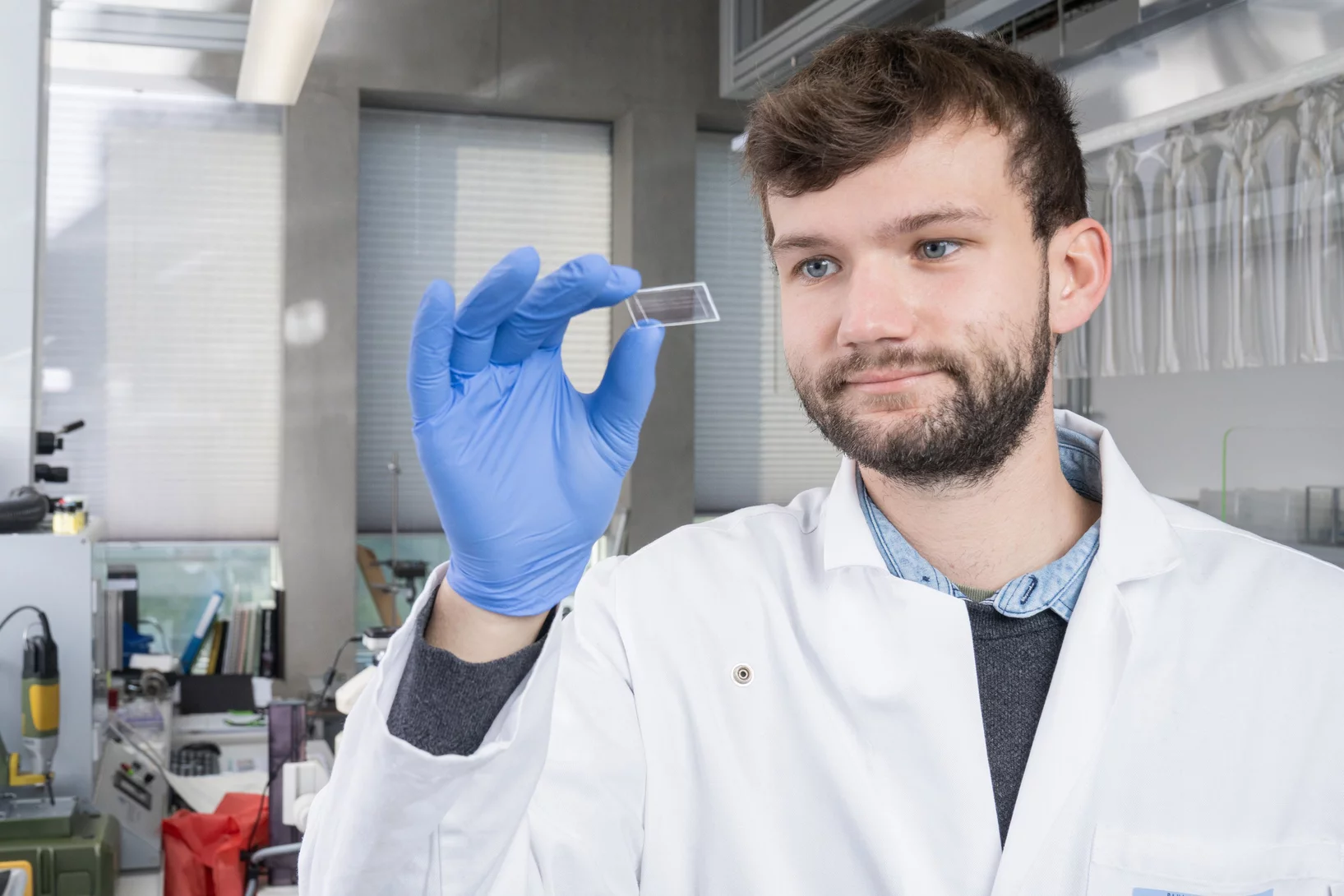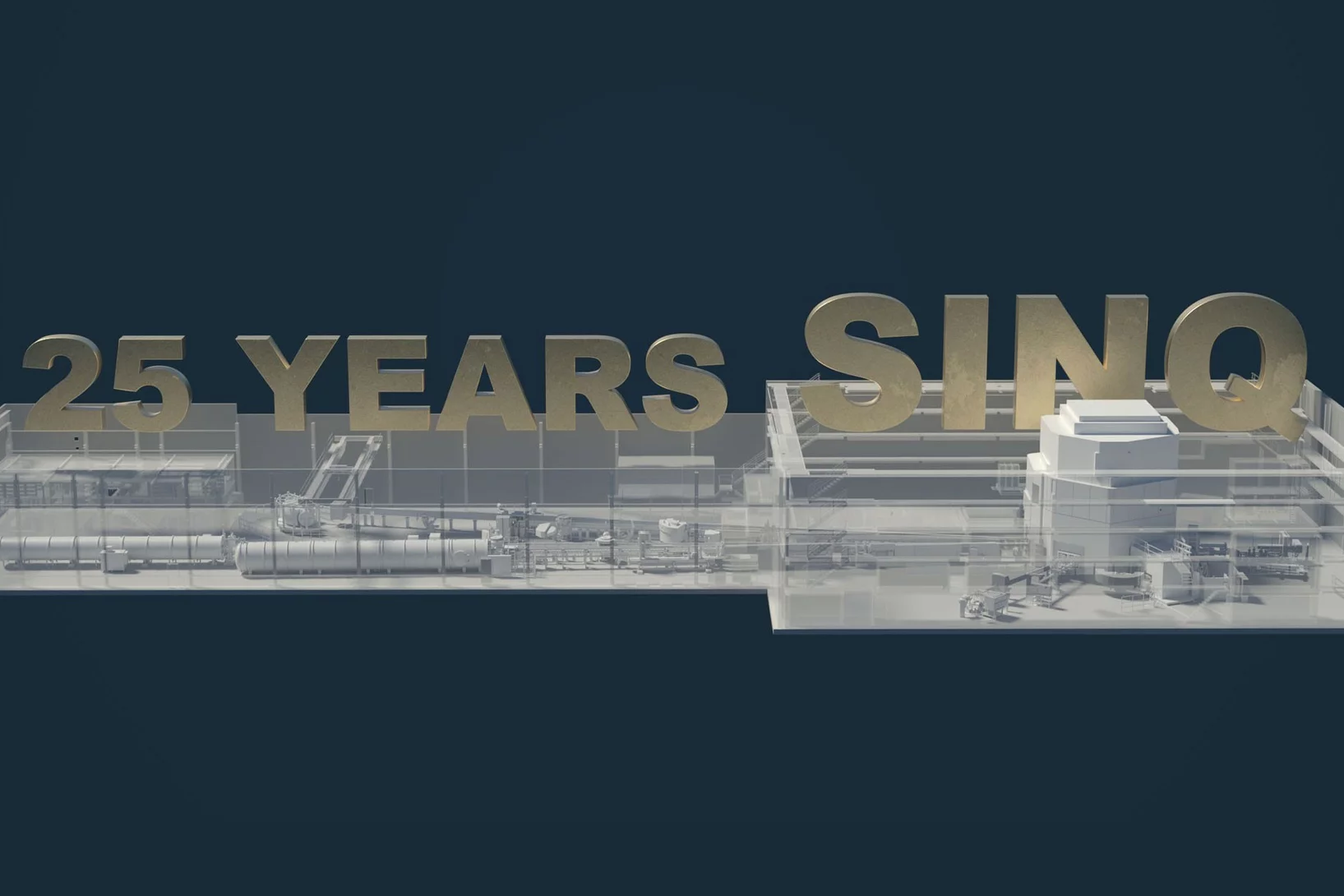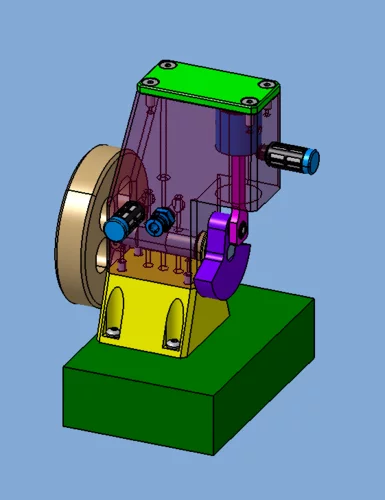At PSI, several projects are dedicated to important research questions concerning the Sars-CoV-2 coronavirus and the resulting diseases. We provide information on activities and projects, for example on investigations of lung tissue, on the production of proteins and antibodies or on ideas for new research on Covid-19.
Useful links
Muon spin spectroscopy
Muons are particles with a spin of 1⁄2 that can be implanted into a wide range of condensed matter materials to act as a local probe of the surrounding atomic environment. Measurement of the muon’s precession and relaxation provides an insight into how it interacts with its local environment. From this, unique information is obtained about the static and dynamic properties of the material of interest ...
Covid-19: New, better coronavirus rapid test
Researchers at the Paul Scherrer Institute PSI and the University of Basel have developed a rapid test for Covid-19. Its novel functional principle promises reliable and quantifiable results concerning a patient's Covid-19 disease and its course – as well as evidence concerning other diseases and Covid variants that may be present.
Now a new test developed at PSI – which, unlike antigen tests, does not directly detect components of the virus, but rather the antibodies the immune system produces in response to the infection –promises to bring substantially more predictive power to rapid testing. It is just as inexpensive, quick, and easy to use, and it can also be used to simultaneously identify a variety of pathogens, such as those responsible for the flu.
Before it can go into widespread use, however, it still must undergo further testing and optimisation.
EU XFEL Young Scientist Award for Camila Bacellar
Camila Bacellar, beamline scientist and group leader of the Alvra endstation at SwissFEL, has received the European XFEL Young Scientist Award. The award recognises the contribution of young scientists to research at the European XFEL.
Taking good and safe care of the retired … nuclear fuel
After several years of loyal and reliable services during heavy duty operation in a reactor, nuclear fuel must be discharged and go into retirement. For Switzerland, the final place of retirement is planned to consist of a deep geological repository where the used nuclear fuel will be disposed. Before the repository is constructed, the used fuel will need to be stored in wet pools and/or dry storage casks.
During all this time, safe handling of the fuel will remain the top priority for operators and regulators. To gain better knowledge on the relevant phenomena which could potentially affect the fuel thermo-mechanics and safety characteristics during long storage periods as well as to allow predicting their evolution, simulation models are being developed at PSI within the DRYstars project.
A first milestone was recently achieved with the development of models coupled to state-of-the-art fuel performance codes for each of the three main categories of phenomena considered as having high safety relevance for storage, namely helium behaviour, creep behaviour and hydrogen behaviour.
New, better coronavirus rapid test
The test identifies different virus variants and improves disease prognosis.
Towards compact quantum computers, thanks to topology
In pursuit of particularly stable quantum bits, researchers have closely examined the electron distribution in two semiconductors.
Update on the Status of HIMB
A workshop to discuss and further develop the science case for the High Intensity Muon Beams (HIMB) has been held.
Direct observation of crack formation mechanisms with operando Laser Powder Bed Fusion X-ray radiography
Operando high-speed X-ray radiography experiments reveal the cracking mechanism during 3D laser printing of a Ni superalloy.
Celebrating 25 years of SINQ
On January 17th, 2022, we celebrated the 25th anniversary of the inauguration of the Swiss Spallation Neutron Source SINQ. Today, SINQ is firmly embedded in the European research landscape and has established itself as an important center for neutron research.
Druckluftmotor: aus nichts als Luft wird kinetische Bewegungsenergie
Am Anfang nur eine einfache Übungsvorlage aus dem Internet, inzwischen eine detaillierte Baugruppe die in der Pandemie seinen Start fand. Nun warten wir bis es in der der Fertigung realisiert wird.
Direct evidence of in situ Co-oxyhydroxide formation on the surface of La0.2Sr0.8CoO3-δ water splitting catalyst
We carried out in situ and ex situ ambient pressure X-ray photoelectron spectroscopy (APXPS) experiments on a La0.2Sr0.8CoO3-δ perovskite oxygen evolution reaction (OER) catalyst. The study shows that Sr is leached into the electrolyte after immersion, leading to surface Co active site enrichment. Such a Co-enriched surface evolves into a new phase during operation. With the help of theoretical simulations, such a species is assigned to Co-oxyhydroxide, providing direct evidence of its formation during the OER.
Revealing invisible defects in fusion reactor armor
In an exciting collaboration, Nick Phillips, a PSI Fellow at the cSAXS beamline, reveals nanoscale lattice distortions created by invisible defects in fusion reactor armor. This work develops the current understanding of how the smallest, but most prevalent defects, generated during neutron irradiation behave. The novel Bragg ptychographic approach published in Nature Communications paves the way for fast, robust, 3D Bragg ptychography.
E-fuels and electrification as complementary approaches to achieve climate target
Sustainable, synthetic fuels, so-called e-fuels, can help reduce CO₂ emissions. For their production, electricity from renewable sources is required in order to allow for a close to CO₂-neutral balance. The availability of electricity from renewable sources, which ensures the climate benefits of e-fuels, is currently still limited. “Especially in order to produce on a larger scale, a lot of renewable electricity is needed,” explains Christian Bauer, researcher at the Laboratory for Energy Systems Analysis (LEA) at PSI.
SμS Call 2022/1 informations
The results of the evaluation of the SμS Call 2022/1 and the beam time schedule will be published mid of March 2022. Resume of HIPA user operation is scheduled to May 2nd, 2022.
Understanding variant selection and texture in additively manufactured red-gold alloys
Synchrotron X-ray diffraction experiments reveal the presence of a non- negligible amount of tetragonal phase in 3D printed red-gold samples.
Millions in funding for brain and quantum research
The European Research Council approves PSI projects for the development of a quantum computer and brain research worth about 5 million euros.
Research for semiconductor electronics
PSI researchers, together with researchers from Cornell University in New York State, have identified a composite material that could integrate quantum devices into semiconductor technology, making electronic components significantly more powerful. Among the most important challenges currently facing semiconductor electronics are improvements that would increase data transmission bandwidth, energy efficiency and information security. The incorporation of quantum effects could provide a new breakthrough and could be trend-setting for the semiconductur-industry.
Confirming the trilinear form of the optical magnetoelectric effect in the polar honeycomb antiferromagnet Co2Mo3O8
Magnetoelectric phenomena are intimately linked to relativistic effects and also require the material to break spatial inversion symmetry and time-reversal invariance. Magnetoelectric coupling can substantially affect light–matter interaction and lead to non-reciprocal light propagation. Here, we confirm on a fully experimental basis, without invoking either symmetry-based or material-specific assumptions, that the optical magnetoelectric effect in materials with non-parallel magnetization (M) and electric polarization (P) generates a trilinear term in the refractive index...
LAC scientists awarded Mariolopoulos Trust Fund Award 2022
The paper "Sources of particulate-matter air pollution and its oxidative potential in Europe" published in Nature by Kaspar Dällenbach and his team at the LAC has won the 2022 Mariolopoulos Trust Fund Award, along with another paper in the field of atmospheric environment.
Precision Measurement of the Lamb Shift in Muonium
We report a new measurement of the n=2 Lamb shift in Muonium. Our result of 1047.2(2.3)stat(1.1)syst MHz comprises an order of magnitude improvement upon the previous best measurement. This value matches ...
More insight into how vision works
PSI scientists have shed light on the structure of an important component of the eye: CNG ion channels whose job is to relay optical signals to the brain.
Marie-Christine Zdora joins the X-ray Tomography Group
The X-ray Tomography group welcomes Marie-Christine Zdora as a new member. In her role as translational X-ray imaging adjunct scientist, Marie will mainly work on phase-contrast and dark-field imaging focusing on the further development of these techniques towards their clinical translation. Before joining TOMCAT, Marie was a postdoc in the X-ray optics and applications group at the Laboratory for Micro- and Nanotechnology (LMN) at PSI, where she worked on the development of new X-ray optics as well as X-ray wavefront sensing. Prior to this position, she was a research fellow at the University of Southampton in the UK, where she made advances in X-ray speckle-based imaging using synchrotron and lab sources.
Reduced capacity PSI guesthouse
There will be some substantial renovation work be going on in the PSI guesthouse until middle of March, which causes a significantly smaller capacity mainly in January and February.
Welcome Fabio Peixoto Esteves
A new colleague, Mr. Fabio Peixoto, started on January 1, 2022 as a PhD student in the van Bokhoven group under Marco Ranocchiari's supervision.
The power of protons
This gallery presents five people who have been treated at the PSI's Center for Proton Therapy.
High-performance detector for DMC enters hot commissioning phase
The cold neutron diffractometer DMC at SINQ is currently undergoing major upgrades. After the recent replacement of the cold neutron guide as part of the SINQ upgrade program, the installation of the new high-performance 2D position-sensitive detector successfully entered the hot commissioning phase.
Semiconductors reach the quantum world
Boosted with superconductivity: Semiconductor technology can get a new twist by exploiting quantum effects in superconductors.
Effective combination cancer treatment
Researchers at the Paul Scherrer Institute PSI have tested various methods to check how effective they are in combatting certain types of cancer. They found a combination of two preparations to be much more effective than treatment with just one of the two active substances. This is particularly important for the treatment of modular thyroid carcinomas. If the results obtained so far are confirmed in future studies, this therapy could be available to the general public in a few years.
3D printed nanomagnets unveil a world of patterns in the magnetic field
Scientists have used state-of-the-art 3D printing and microscopy to provide a new glimpse of what happens when taking magnets to three-dimensions on the nanoscale – 1000 times smaller than a human hair.
Terbium Triumph
Bench-to-bedside successes: Fruitful collaborations at PSI’s Center for Radiopharmaceutical Sciences make bringing Terbium-161 to the clinic a reality.


























